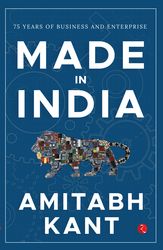How did a trundling elephant transform into a roaring lion? When the parallelism is about India, there could be two ways of looking at it, depending on which side of the ideological divide you are on. Except in one literal instance when it was, indeed, the case.
As technocrat Amitabh Kant reveals in his new book, Made in India: 75 Years of Business and Enterprise, the logo initially selected for the government’s ambitious ‘Make in India’ campaign for its thrust into domestic manufacturing was that of an elephant. The design, done by advertising and design professional V. Sunil, was even ready. But Prime Minister Narendra Modi had other ideas.
“We made three presentations to the PM on the logo and branding of Make in India. After several rounds of discussion with the PM, it was changed into a lion, derived from the Ashoka Chakra,” Kant, now India’s G20 Sherpa, writes.
Anecdotes like this, especially those of his interactions and comfort factor with Modi, light up the book. Kant, for instance, had applied to head the Competition Commission of India (CCI) after retirement, but Modi disagreed and told him, “You will have my blessing, but not for this post”. Modi made him CEO of NITI Aayog, a move which initially disappointed Kant as the newly created body had “none of the power, authority or resources of the body it replaced, the Planning Commission”. Though Kant later admitted, “looking back, these were some of the best years” of his career.
There are also anecdotes about others, like his recollection of his meeting with then prime minister Vajpayee in Kumarakom which eventually paved the way for his transfer to Delhi from the Kerala cadre, or how he swam against the wave to mastermind the tourism branding exercise ‘Incredible India’ in 2002.
Yet, Kant loses no time in hurtling off into a whirlwind tour through India’s economic and business history. Nowhere along this ‘expressway’ journey does he lose sight of his eventual destination of ‘Amrit Kaal’.
The book kicks off on the eve of colonial rule, when India’s share in the world’s GDP was estimated to have been 24 per cent (no credit given to the Mughals, though) and then progresses onward to decipher how India’s economy shrank even as the Raj reached its zenith. Then, after a gleeful recounting of the pitfalls of the post-Independence ‘licence raj’, Kant paints the 1991 liberalisation attempts as unsurprisingly “incomplete” and surprisingly “a bottleneck to India’s growth and prosperity”, before launching into an exuberant and laudatory second half of the book chronicling the Modi years.
While the slant is crystal clear, Kant is careful not to fall into the propaganda trap. Better, the book gives a concise, compact and captivating overview of India’s economic history―right from the family-held businesses of the Raj down to today’s startup innovators.
Particularly interesting―and this is something we don’t find in most history books―are the lucid recounting of the stories behind the policies that shaped and transformed Indian economy in the tumultuous years before and after independence, right from the Congress’s own National Planning Committee (1938) to industrialists getting together to put out the Bombay Plan (1944) to the Soviet-esque Five Year Plans (1951) and the Planning Commission.
Kant’s latest is a great way to get the big picture. And with the ringside view he has had of Indian bureaucracy and politics as the trundling elephant transformed into a roaring lion (or kind of), we would be awaiting what Kant will come up with next. Our suggestion: more anecdotes, please.
Made in India; 75 Years of Business and Enterprise
By Amitabh Kant
Published by Rupa Publications
Pages 222 Price Rs595 (Hardbound)


